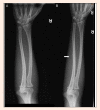Stress fracture of the ulna in a break-dancer
- PMID: 24149966
- PMCID: PMC3761912
Stress fracture of the ulna in a break-dancer
Abstract
Break dancing is a popular activity in teenagers and is associated with severe trauma to bones and tissues. We report the first known case of a break dancer with an ulnar stress fracture. Such injuries occur in a variety of sports due to substantial stress on the ulna and repetitive excessive rotation of the forearm. In this study we describe a patient who experienced an ulnar stress fracture during break dancing training. The diagnosis was established by history and physical examination. Initial radiographic findings were negative. However, radiographs taken 3 months after initial presented revealed callus formation over the ulnar shaft. This suggested that readjustment is required in break dancing training protocols. It is important to increase awareness of this injury among physicians to expedite the diagnosis and to prevent the possibility of conversion to an overt fracture in the future. Key pointsStress fractures should not be ignored when the patient changes exercise loading.A thoroughly detailed clinical history, physical examination, and plain radiographs were used diagnostically in this clinical case.The best methods for the treatment of stress fractures include readjustment training protocols to prevent conversion to overt fractures.
Keywords: Sports injuries; magnetic resonance imaging; stress fractures; ulna fractures.
Figures


Similar articles
-
Stress fracture of the ulna in an elite ice dancer.J Sports Sci Med. 2015 Mar 1;14(1):37-40. eCollection 2015 Mar. J Sports Sci Med. 2015. PMID: 25729287 Free PMC article.
-
Ulnar shaft stress fractures in fast-pitch softball pitchers: a case series and proposed mechanism of injury.Skeletal Radiol. 2021 Apr;50(4):835-840. doi: 10.1007/s00256-020-03624-4. Epub 2020 Sep 25. Skeletal Radiol. 2021. PMID: 32978679 Review.
-
Bilateral stress fractures of the ulna in a young adolescent.J Pediatr Orthop B. 2012 Nov;21(6):520-4. doi: 10.1097/BPB.0b013e328354db2f. J Pediatr Orthop B. 2012. PMID: 22744236 Review.
-
[Plate Osteosynthesis of Distal Ulna Fractures with Associated Distal Radius Fractures Treated by Open Reduction and Internal Fixation. Short-Term Functional and Radiographic Results].Acta Chir Orthop Traumatol Cech. 2015;82(5):369-76. Acta Chir Orthop Traumatol Cech. 2015. PMID: 26516956 Czech.
-
Stress fracture at the junction of the middle and distal third of the ulnar diaphysis in a spinner bowler: a case report and a review of the literature.Knee Surg Sports Traumatol Arthrosc. 2005 Sep;13(6):499-504. doi: 10.1007/s00167-004-0560-2. Epub 2004 Nov 13. Knee Surg Sports Traumatol Arthrosc. 2005. PMID: 16170585 Review.
Cited by
-
Stress fracture of the ulna in an elite ice dancer.J Sports Sci Med. 2015 Mar 1;14(1):37-40. eCollection 2015 Mar. J Sports Sci Med. 2015. PMID: 25729287 Free PMC article.
-
Ulnar shaft stress fracture in a high school softball pitcher.Sports Health. 2010 Mar;2(2):116-8. doi: 10.1177/1941738109357300. Sports Health. 2010. PMID: 23015929 Free PMC article.
-
Ulnar shaft stress fractures in fast-pitch softball pitchers: a case series and proposed mechanism of injury.Skeletal Radiol. 2021 Apr;50(4):835-840. doi: 10.1007/s00256-020-03624-4. Epub 2020 Sep 25. Skeletal Radiol. 2021. PMID: 32978679 Review.
-
Ulnar stress fracture in a softball player.Clin Case Rep. 2020 May 28;8(8):1547-1552. doi: 10.1002/ccr3.2933. eCollection 2020 Aug. Clin Case Rep. 2020. PMID: 32884793 Free PMC article.
References
-
- Broome H.E., Heppenstall R.B. (1985) Break dancers' bursitis. The Journal of the American Medical Association 253, 777 - PubMed
-
- Byun H.S., Cantos E.L., Patel P.P. (1986) Severe cervical injury due to break dancing. A case report. Orthopedics, 9, 550-551 - PubMed
-
- Dorey R.S., Mayne V. (1986) Break-dancing injuries. The Medical Journal of Australia 144, 610-611 - PubMed
-
- Escher S.A. (1997) Ulnar diaphyseal stress fracture in a bowler. The American Journal of Sports Medicine 25, 412-413 - PubMed
LinkOut - more resources
Full Text Sources
